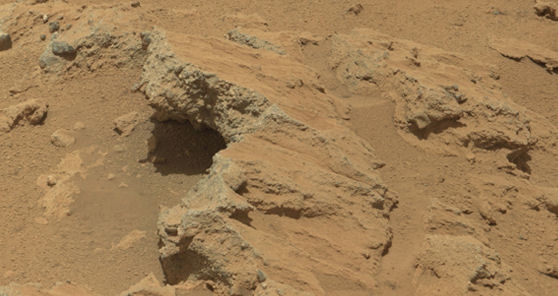Science News
Down by the Old Mars Stream
September 28, 2012

On Thursday, NASA held a news briefing on the latest Curiosity rover find on Mars: evidence a stream that once ran vigorously across the area where the rover is now driving.
This is exciting as it gives us more evidence that the dry, red planet used to be wet with water. There is earlier evidence for the presence of water on Mars, but this evidence—images of rocks (like the one to the right) containing ancient streambed gravels—is the first of its kind. The sizes and shapes of stones in these images offer clues to the speed and distance of a long-ago stream’s flow.
“From the size of gravels it carried, we can interpret the water was moving about three feet per second, with a depth somewhere between ankle and hip deep,” says Curiosity science co-investigator William Dietrich of UC Berkeley. “Plenty of papers have been written about channels on Mars with many different hypotheses about the flows in them. This is the first time we're actually seeing water-transported gravel on Mars. This is a transition from speculation about the size of streambed material to direct observation of it.”
“The shapes tell you they were transported and the sizes tell you they couldn't be transported by wind. They were transported by water flow,” concurs Curiosity science co-investigator Rebecca Williams of the Planetary Science Institute.
The science team may use Curiosity to learn the elemental composition of the material, revealing more characteristics of the wet environment that formed these deposits.
The slope of Mount Sharp in Gale Crater remains the rover’s main destination. Clay and sulfate minerals detected there from orbit can be good preservers of carbon-based organic chemicals that are potential ingredients for life.
“A long-flowing stream can be a habitable environment,” says Mars Science Laboratory project scientist John Grotzinger of Caltech. “It is not our top choice as an environment for preservation of organics, though. We're still going to Mount Sharp, but this is insurance that we have already found our first potentially habitable environment.”
Image: NASA/JPL-Caltech/MSSS